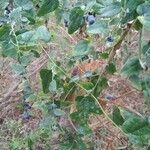Liane reaching several metres in length; young branchlets ± densely pubescent-tomentose.. Leaves yellowish-tomentose, petiole 0.5–2.5 cm. long; blade various in shape, that of the leaves in the lower part of the main branches clearly 3–5-lobed, that of the other leaves narrowly to broadly ovate, ovate-oblong or obovate, base broadened, cuneate, ± rounded or rarely cordate, apex obtuse to rounded and mucronulate, 4–8 (–9) cm. long, (2.5–6) –7 cm. wide, bract-like and then 0.5 cm. long at the ends of the lateral and flowering branchlets, densely tomentellous when young, later sparsely tomentellous to glabrescent; basal nerves 5.. Male inflorescences of many-flowered cymules clustered 2–3 together or rarely solitary, 1–2.5 cm. long; peduncle up to 1.5 cm. long; pedicels 0.5–1 mm. long.. Male flowers with long-hairy sepals, the 3 inner broadly ovate or obovate, 1.5–2.5 mm. long, 1.7–2 mm. wide, the 3 outer oblong to lanceolate, 1.4–2 mm. long, 0.4–0.8 mm. wide; petals ovate-oblong, 0.5–1.5 mm. long, 0.3–0.6 mm. wide, sparsely pubescent to glabrescent; stamens 0.7–1 mm. long.. Female inflorescences 0.5–2.5 cm. long.. Female flowers with staminodes 0.5 cm. long; carpels 0.7–1 mm. long.. Drupes 4–8 mm. long, 4–5 mm. wide; endocarp clearly ribbed on the lateral faces and with a prominent dorsal crest; septum of the condyleperforated.. Fig. 3, p. 11.
Leaves yellowish-tomentose; lamina 4–8 (9) x 2.5–6 (7) cm., variable in shape, that of the leaves in the lower part of the main branches clearly 3–5-lobed, that of the other leaves narrowly to broadly ovate, ovate-oblong or obovate, base broadened, cuneate, more or less rounded or rarely cordate, apex obtuse to rounded and mucronulate, bract-like and then 0.5 cm. long on the lateral and flowering branchlets, densely tomentellous when young, later sparsely tomentellous to glabrescent, basal nerves 5, petiole 0.5–2.5 cm. long.
Male flowers with pilose sepals, the 3 inner 1.5–2.5 x 1.7–2 mm., broadly ovate or obovate, the 3 outer 1.4–2 x 0.4–0.8 mm., oblong to lanceolate; petals 0.5–1.5 x 0.3–0.6 mm., ovate-oblong, sparsely pubescent to glabrescent; stamens 0.7–1 mm. long.
Male inflorescences of many-flowered cymules clustered 2–3 together or rarely solitary, 1–2.5 cm. long; peduncle up to 1.5 cm. long; pedicels 0.5–1 cm. long.
Drupelets 4–8 x 4–5 mm.; endocarp clearly ribbed on the lateral faces and with a prominent dorsal crest; septum of the condyle perforated.
Twining, woody creeper. Leaves pubescent, ovate, veins conspicuous, apex obtuse and mucronulate. Flowers yellowish green.
Climber reaching several metres in length; young branchlets ± densely pubescent, tomentose.
Female flowers with staminodes 0.5 cm. long; carpels 0.7–1 mm. long.
Female inflorescences 0.5–2.5 cm. long.

